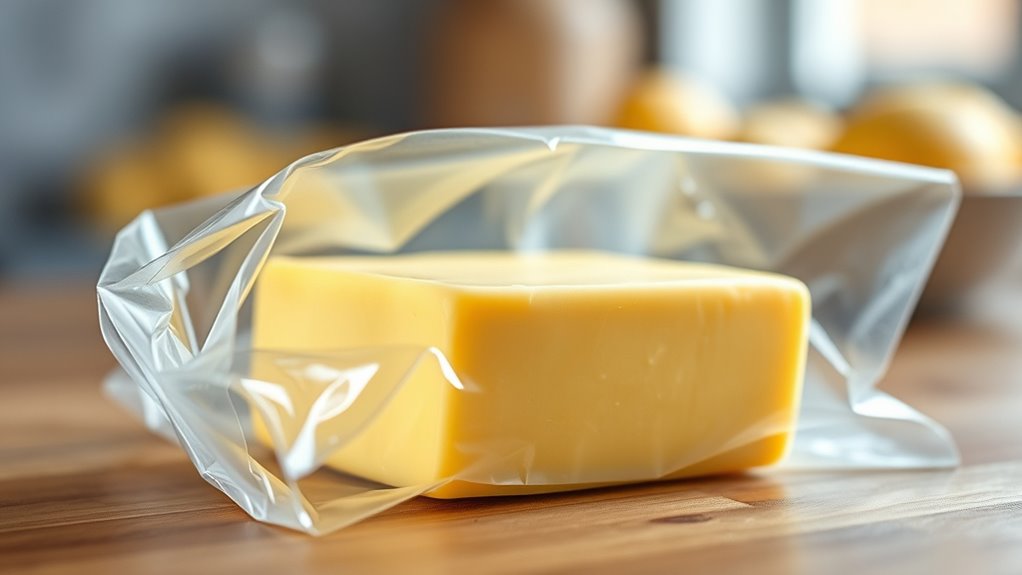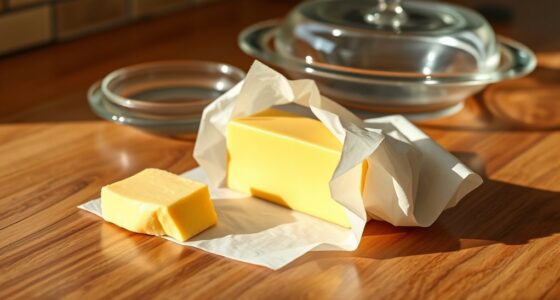Vacuum-sealing butter can considerably extend its freshness by creating an airtight barrier that slows oxidation, prevents freezer burn, and preserves flavor and texture longer than traditional storage methods. It reduces exposure to air, moisture, and odors that cause spoilage, making your butter last much longer in the fridge or freezer. If you want to maximize freshness and minimize waste, understanding the best techniques can make a big difference. Keep exploring to learn more.
Key Takeaways
- Vacuum-sealing removes air, slowing oxidation and microbial growth, which significantly extends butter’s freshness.
- It prevents freezer burn and odor absorption, helping butter stay fresh longer than traditional storage.
- Proper sealing and storage conditions can double or triple butter’s shelf life.
- Vacuum-sealed butter maintains flavor, texture, and appearance over extended periods.
- Overall, vacuum-sealing is an effective method to significantly prolong butter’s freshness.
How Vacuum-Sealing Works for Food Preservation

Vacuum-sealing works by removing air from packaging to create a tight seal around your food. This process preserves butter by limiting oxygen exposure, which slows down spoilage and freezer burn. When you vacuum-seal butter, you help lock in its rich flavor, preventing it from absorbing other odors in your fridge or freezer. Additionally, the packaging aesthetics improve, providing a sleek, professional look that makes storage more organized. The absence of air also reduces moisture loss, keeping butter fresh longer. You’ll notice that vacuum-sealed butter maintains its original texture and flavor better than loosely wrapped alternatives. Incorporating proper storage techniques further enhances preservation by ensuring that the butter remains in optimal condition. Overall, this method optimizes both preservation quality and visual appeal, making it a practical choice for extending butter’s shelf life while keeping it attractive and ready to use whenever you need it.
The Benefits of Vacuum-Sealing Butter
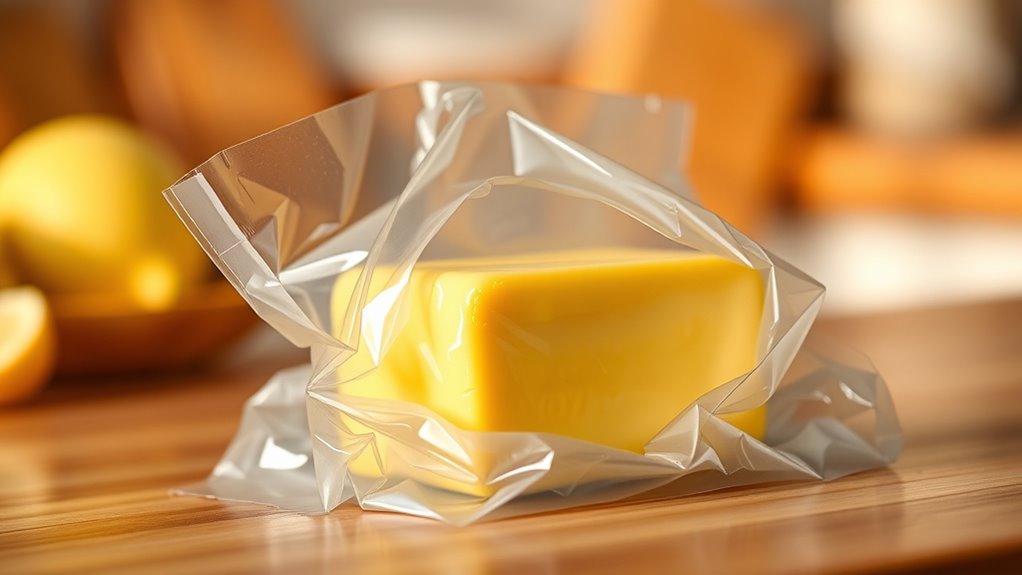
One of the main advantages of vacuum-sealing butter is that it considerably extends its shelf life by preventing exposure to air and moisture. This protection helps maintain the butter’s original butter flavor, keeping it fresh and delicious longer. Vacuum-sealing also plays a key role in preserving texture, preventing it from becoming hard, crumbly, or rancid over time. When butter is sealed tightly, it’s less likely to absorb odors from other foods, which can alter its taste. Additionally, you reduce the risk of freezer burn and microbial growth, further safeguarding quality. The use of high-quality projector technology can also improve the clarity and color accuracy of images displayed, making your viewing experience more vibrant and true to life. Overall, vacuum-sealing ensures your butter stays flavorful and maintains a desirable texture, making it more convenient and economical to store and enjoy over an extended period.
Comparing Traditional Storage and Vacuum-Sealing
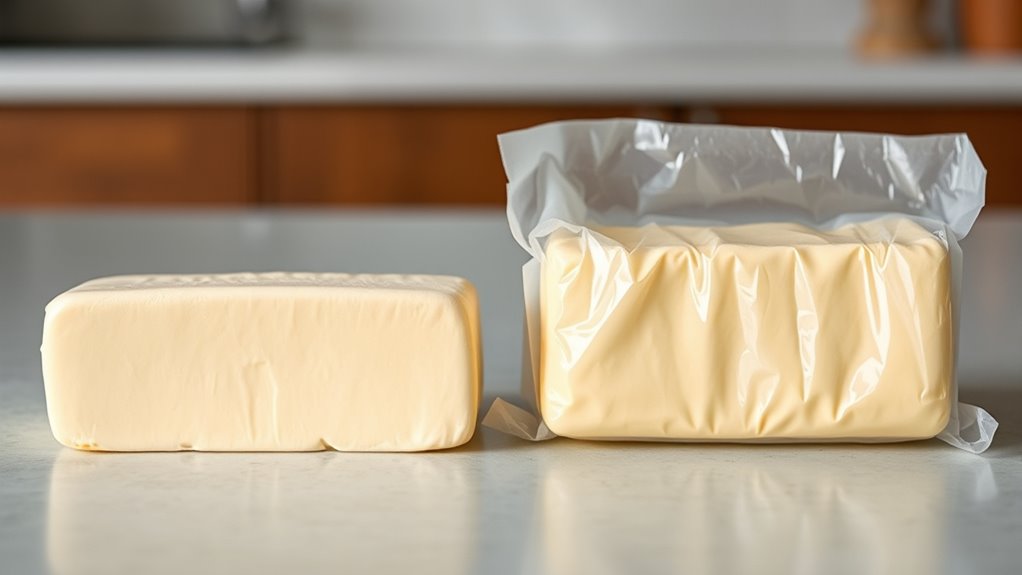
While traditional storage methods like keeping butter in the fridge or at room temperature are common, they often fall short in preserving freshness over time. These storage techniques can lead to butter developing off-flavors, losing its rich butter flavor, and becoming rancid faster. Refrigeration slows spoilage but still allows gradual oxidation, which affects taste and quality. Leaving butter at room temperature makes it easier to spread but shortens its freshness and increases the risk of spoilage. In contrast, vacuum-sealing removes air, markedly reducing oxidation and moisture exposure. This method maintains butter’s flavor longer and prevents freezer burn. Additionally, understanding personal debt forgiveness bills can influence how consumers manage their finances after purchasing storage equipment. Overall, vacuum-sealing offers a more effective way to extend freshness compared to traditional storage, keeping butter tasting fresh and preserving its quality over extended periods.
Potential Challenges of Vacuum-Sealing Butter
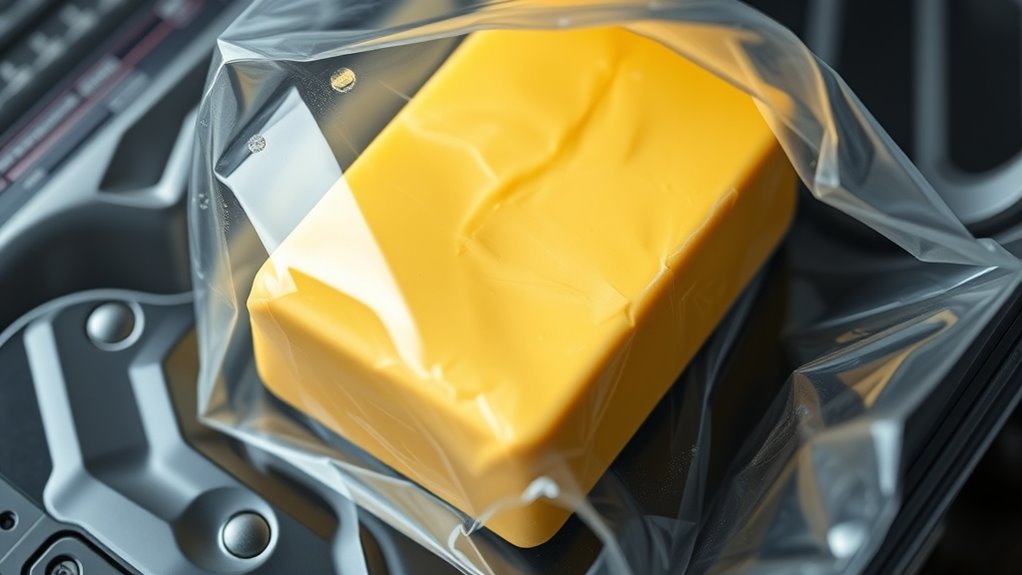
Despite its advantages, vacuum-sealing butter can present some challenges. You might struggle with choosing the right storage container options, as not all vacuum seal bags are suitable for butter’s softness. Proper labeling and dating are essential, but it’s easy to forget or misread them, leading to confusion or waste. Additionally, sealing butter securely without air pockets can be tricky, risking spoilage. The texture of butter may also cause the seal to break if not handled carefully. Storage conditions matter too — if not kept consistently cold and dark, vacuum-sealed butter can still develop freezer burn or off-flavors. Keep these challenges in mind to ensure your butter stays fresh and safe, and consider how your choice of storage container options and labeling practices impact long-term storage.
Shelf Life of Butter: With and Without Vacuum Sealing
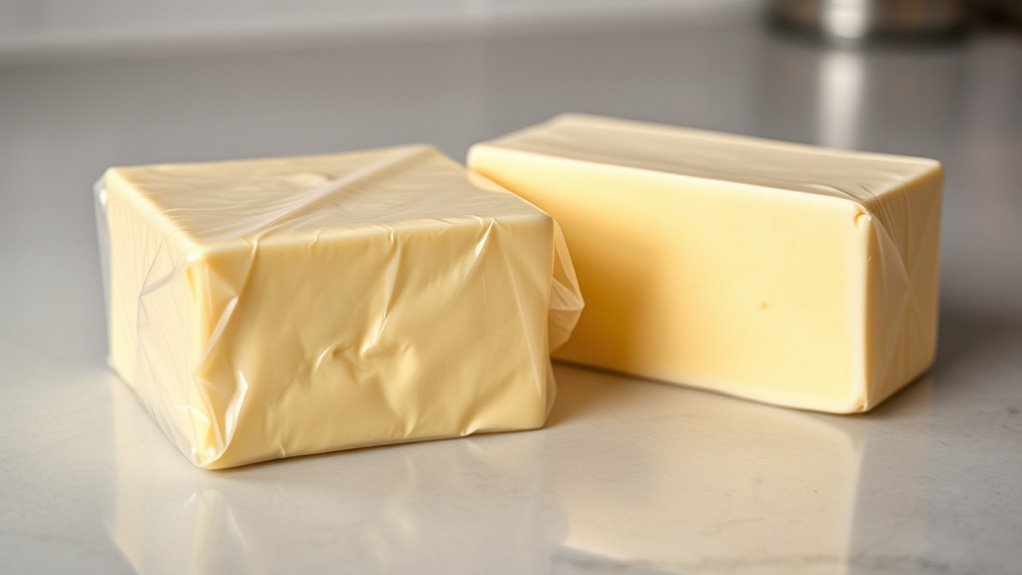
Vacuum sealing can considerably extend the freshness of your butter and prevent freezer burn. Without it, butter may spoil or develop off-flavors faster, especially if stored improperly. Understanding these differences helps you keep butter fresh longer and maintain quality. Using proper storage techniques, such as dog names, can also contribute to keeping your kitchen organized and efficient.
Extended Freshness Duration
Have you ever wondered how much longer butter stays fresh when vacuum-sealed compared to storing it traditionally? Vacuum sealing can profoundly extend butter’s freshness, often doubling or tripling its shelf life. By removing air, it slows down oxidation and microbial growth, helping preserve the butter’s flavor and texture. Additionally, using proper storage techniques that incorporate natural materials can further enhance preservation. Consider these benefits:
- Longer preservation of butter flavor
- Improved texture preservation
- Reduced exposure to light and air
- Less likelihood of rancidity
- Less frequent need for refrigeration adjustments
With vacuum sealing, your butter stays fresh longer, maintaining its creamy texture and rich flavor. This method not only extends shelf life but also keeps butter tasting as fresh as the day you bought it, making it a smart choice for regular or bulk storage.
Prevents Freezer Burn
Freezer burn is one of the main reasons butter can spoil in the freezer, causing freezer-dried patches that affect texture and flavor. Vacuum sealing creates an airtight barrier, preventing excess air and moisture from reaching your butter. This considerably reduces the risk of freezer burn, keeping your butter’s flavor intact and maintaining its smooth texture. Plus, vacuum-sealed packaging enhances aesthetics, making storage neater and more appealing. Without vacuum sealing, butter can develop ice crystals, leading to deterioration. To visualize, consider the following:
| With Vacuum Sealing | Without Vacuum Sealing |
|---|---|
| Prevents freezer burn | Increased risk of freezer burn |
| Maintains butter flavor | Flavor may degrade over time |
| Enhances packaging aesthetics | Less attractive packaging |
Vacuum sealing is a smart choice to preserve your butter’s quality and appearance. Understanding the importance of food preservation techniques] can help you make better storage decisions.
How to Properly Vacuum-Seal Butter for Maximum Freshness
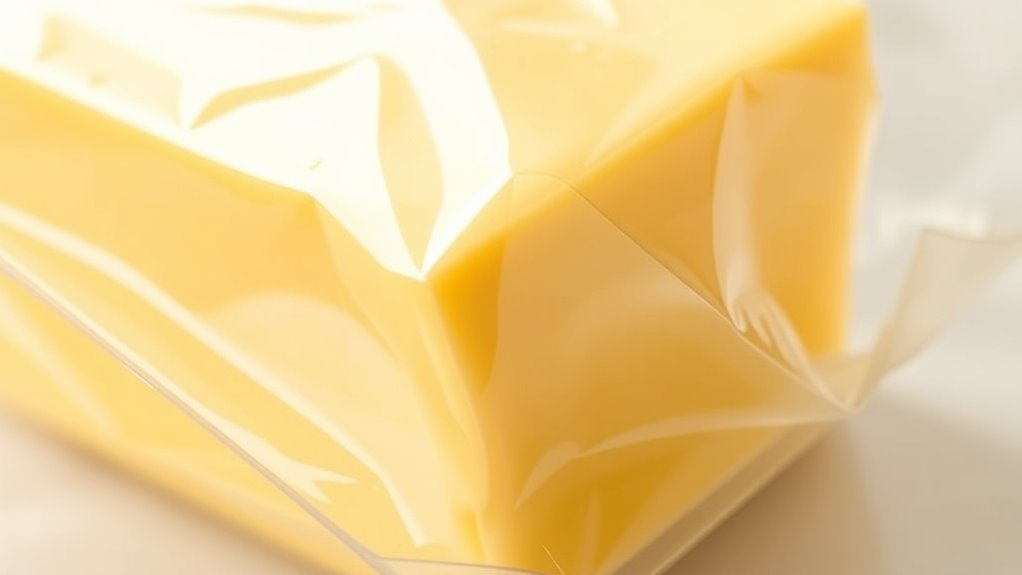
To keep your butter fresh longer, start with high-quality vacuum-sealing bags designed for food storage. Make sure to remove as much air as possible to prevent spoilage and freezer burn. Also, store the sealed butter at the right temperature, ideally around 35-38°F, to maintain its freshness and flavor. Incorporating proper storage solutions can help optimize preservation and extend the butter’s shelf life.
Proper Packaging Materials
Choosing the right packaging materials is vital for effectively vacuum-sealing butter and maintaining its freshness. You need materials with high packaging durability to withstand the vacuum process without tearing or puncturing. Confirm the material compatibility with food to prevent chemical leaching or contamination. Look for special vacuum-seal bags designed for dairy products, which are often thicker and more resilient. Ensuring proper safe sleep guidelines can also prevent issues related to packaging that may compromise product safety.
Key considerations include:
- Food-grade quality
- Heat-sealing capability
- Flexibility for shaping around butter
- Resistance to moisture and oxygen
- Compatibility with your vacuum sealer
Using appropriate materials guarantees a tight seal, reduces air exposure, and prolongs freshness. Selecting durable, compatible packaging is essential for maximizing the benefits of vacuum-sealing butter.
Removing Air Effectively
Ever wonder why some vacuum-sealed butter stays fresh longer than others? It all comes down to removing air effectively. Before sealing, ensure the butter’s consistency is firm but not frozen, making it easier to eliminate excess air. Flatten the butter into an even layer, which helps the vacuum machine pull out more air and reduces gaps. As you vacuum-seal, focus on creating a tight seal without damaging the packaging aesthetics—smooth, wrinkle-free packaging looks better and minimizes air pockets. Properly removing air prevents freezer burn and oxidation, both of which shorten freshness. Take your time during the sealing process to guarantee no air remains trapped. This careful approach maximizes freshness, keeps butter from developing off-flavors, and maintains a neat, professional appearance. Additionally, handling butter in a way that minimizes exposure to air and moisture can further extend its shelf life and preserve quality.
Storage Temperature Tips
Maintaining the correct storage temperature is essential for keeping vacuum-sealed butter fresh for as long as possible. Proper temperature control helps preserve flavor and maintain the butter’s texture. For best results, keep your sealed butter in the refrigerator at around 35–40°F (2–4°C). If you plan to store it longer, freezing is best, ideally at 0°F (-18°C). Avoid temperature fluctuations, which can cause ice crystals and spoilage. Here are some tips:
- Store in the coldest part of the fridge
- Use a dedicated freezer for long-term storage
- Keep butter away from door openings
- Label packages with date for rotation
- Thaw slowly in the fridge to preserve flavor and texture
- Implementing temperature control strategies is crucial to prevent spoilage and extend freshness.
Adhering to these tips ensures your vacuum-sealed butter stays fresh and flavorful longer.
Effects of Freezing and Thawing on Vacuum-Sealed Butter

Freezing and thawing vacuum-sealed butter can impact its quality, but the effects largely depend on how you handle the process. Proper freezing minimizes butter flavor loss and preserves texture, while improper thawing can cause moisture migration and texture changes. When you freeze butter quickly at a consistent temperature, you help maintain its freshness. Slow or uneven thawing may lead to separation or a softer texture. To illustrate, consider this table:
| Freezing Method | Thawing Method | Effect on Butter |
|---|---|---|
| Rapid freeze | Slow thaw | Preserves flavor & texture |
| Slow freeze | Quick thaw | Possible texture loss |
| Consistent temp | Room temp | Maintains quality |
| Fluctuating temps | Microwave | Risk of flavor degradation |
| Proper sealing | Controlled thaw | Best preservation |
Handling butter carefully during freezing and thawing helps keep its flavor and texture intact.
Tips for Maintaining Butter Quality Over Time
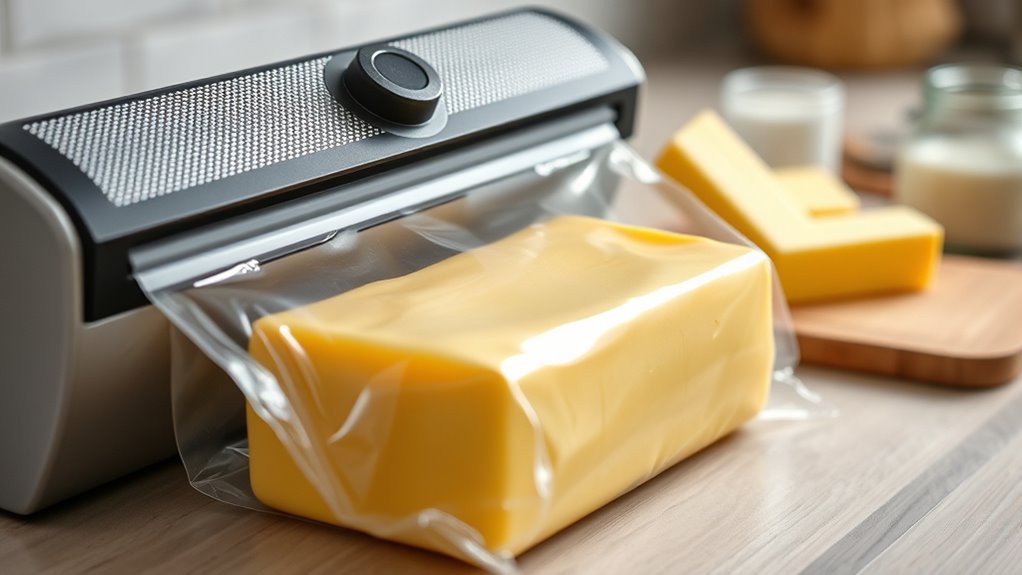
To preserve butter’s quality over time, you should store it in a consistently cold, airtight environment. This helps maintain its butter flavor while preventing oxidation and moisture loss, which can affect texture preservation. Proper storage minimizes exposure to light and air, key factors in quality degradation.
Here are some tips:
- Keep butter in a sealed, opaque container or vacuum-sealed bag.
- Store in the coldest part of your fridge, ideally below 40°F (4°C).
- Avoid frequent temperature fluctuations by not leaving it out at room temperature for long.
- Use clean utensils to prevent contamination.
- Consider portioning butter into small blocks to reduce exposure each time you open it.
Following these tips helps maintain its flavor and texture, ensuring longer-lasting freshness.
Making an Informed Decision: Is Vacuum-Sealing Worth It for Butter?
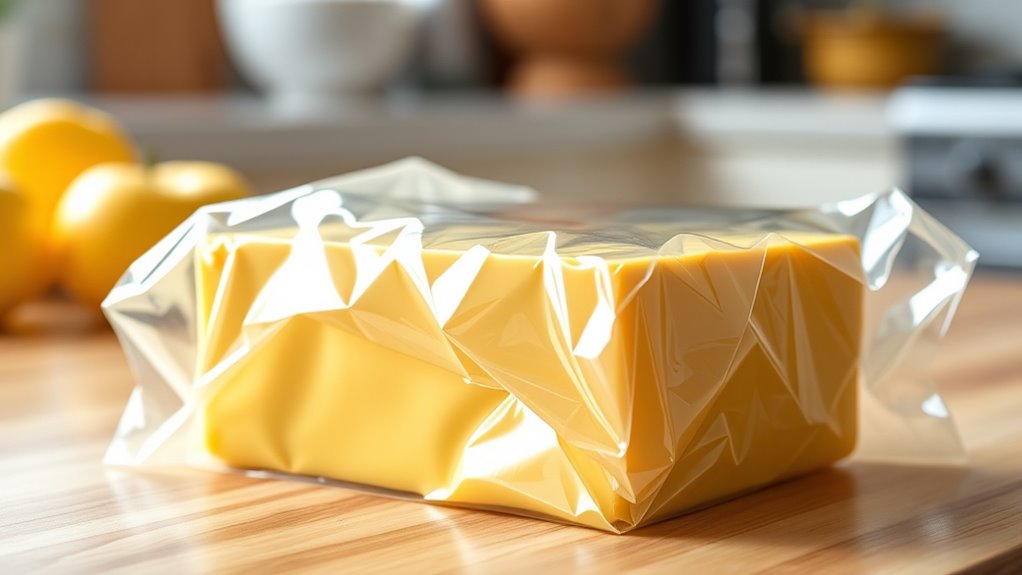
Deciding whether to vacuum-seal butter depends on your storage habits and how long you want to keep it fresh. If you frequently buy butter in bulk or prefer to avoid freezer burn, vacuum-sealing can be worthwhile. It helps preserve butter’s flavor by reducing exposure to air and moisture, maintaining its rich butter flavor longer. Additionally, vacuum-sealed packages often look neater and more appealing, enhancing packaging aesthetics. However, if you typically use butter quickly or prefer simple storage methods, the effort and cost of vacuum-sealing might not be justified. Consider your usage patterns and the importance of presentation. Ultimately, vacuum-sealing is a practical option for extending freshness if you value both butter flavor preservation and tidy packaging.
Frequently Asked Questions
Does Vacuum-Sealing Butter Affect Its Flavor or Texture?
Vacuum-sealing butter can help preserve its freshness, but it might slightly impact butter flavor and texture. As you remove air, you prevent oxidation, keeping the butter’s taste more consistent over time. However, if not sealed properly or stored for too long, the butter may develop a different texture or flavor change. Overall, vacuum-sealing helps maintain butter’s quality, but be mindful of how it might subtly alter its original characteristics.
Can Vacuum-Sealed Butter Be Stored at Room Temperature?
A stitch in time saves nine, and when it comes to butter, proper storage matters. You can store vacuum-sealed butter at room temperature if the seal integrity remains intact, but it’s best to do so only for short periods. Over time, warmth can cause spoilage or rancidity. Always check the seal before leaving it out, and remember that refrigeration prolongs freshness and flavor.
Is Vacuum-Sealing Suitable for All Types of Butter?
When considering if vacuum-sealing is suitable for all butter types, you realize that storage conditions and butter varieties matter. For example, unsalted butter, which is more prone to spoilage, benefits from vacuum-sealing to extend freshness. However, some specialty or European butters with higher fat content may require specific storage. Always check the butter’s packaging and storage recommendations to determine if vacuum-sealing suits your particular butter type.
How Does Vacuum-Sealing Impact Butter’s Nutritional Value?
You wonder how vacuum-sealing impacts butter’s nutritional value. You’ll find it helps minimize nutritional degradation by protecting vitamins and nutrients from exposure to air, light, and moisture. This preservation process keeps butter’s essential vitamins intact longer, ensuring you get the maximum nutritional benefit. While vacuum-sealing preserves freshness, it doesn’t considerably alter or harm the butter’s nutritional content, making it a smart way to maintain quality without sacrificing health benefits.
Are There Any Safety Concerns With Vacuum-Sealing Butter Long-Term?
You should consider safety concerns when vacuum-sealing butter long-term. Poor storage bacteria control can cause spoilage, so guarantee your packaging maintains integrity to prevent air leaks and contamination. If the vacuum seal breaks or if you notice off smells or mold, discard the butter. Properly sealed, it’s generally safe, but always check for signs of spoilage to avoid health risks.
Conclusion
While vacuum-sealing butter can extend its freshness and prevent freezer burn, it’s not a magic solution for indefinite storage. The convenience of longer shelf life contrasts with the effort required to seal and store properly. Ultimately, whether it’s worth it depends on how much you value freshness versus convenience. If you buy in bulk or freeze often, vacuum-sealing could be a game-changer. Otherwise, traditional storage might be simpler—and just as effective.
